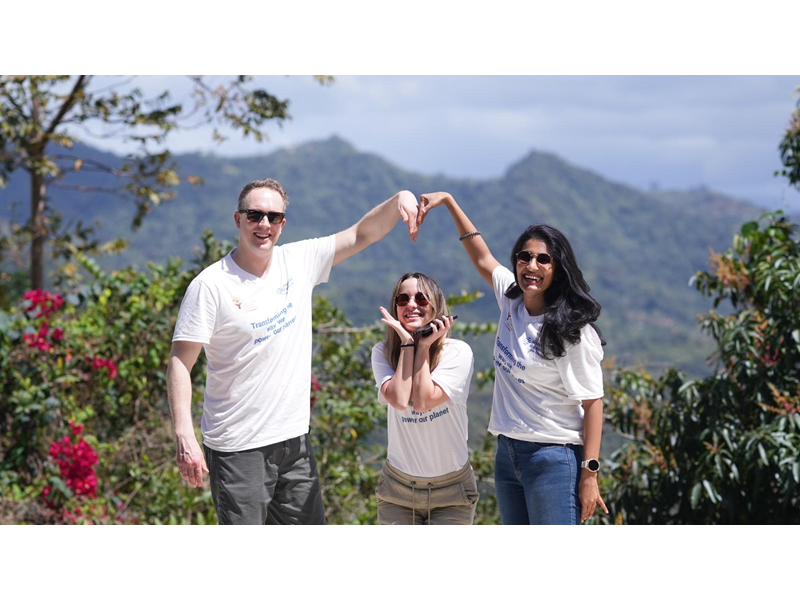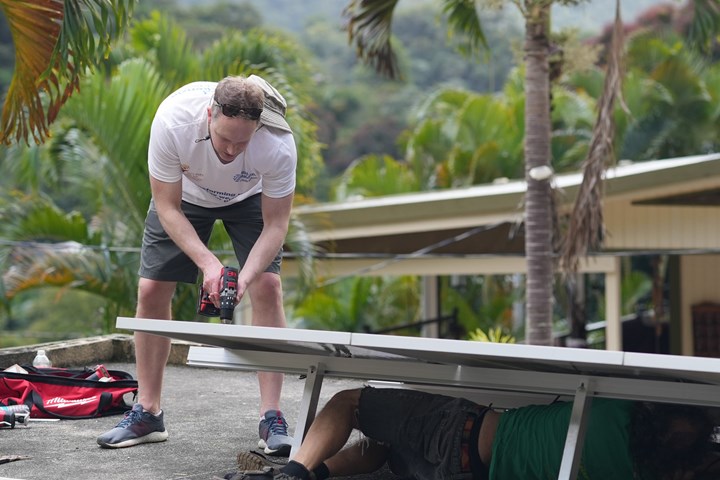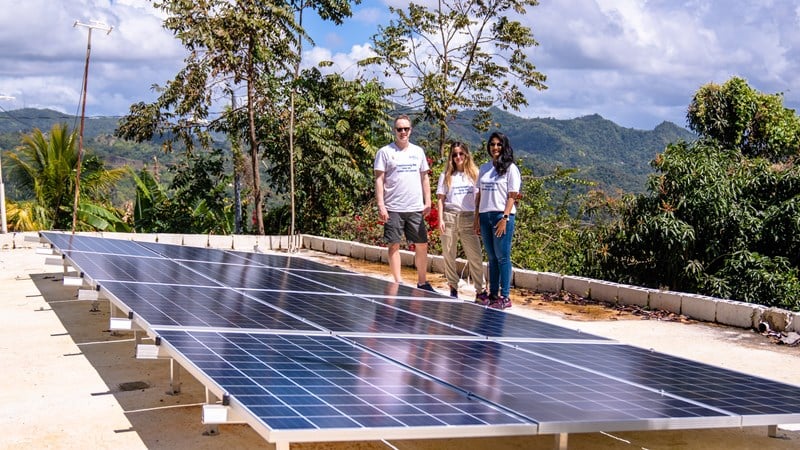Discuss your challenges with our solutions experts
Let's Share the Sun: broadening energy access
Providing reliable energy access to homes in Adjuntas, Puerto Rico
1 minute read
Luke Lewandowski
Vice President, Global Renewables Research

Luke Lewandowski
Vice President, Global Renewables Research
Luke heads our Global Renewables Research team, which includes wind, solar and energy storage.
Latest articles by Luke
-
Opinion
eBook | Navigate power market uncertainty with confidence: the essential guide to profitable energy investments
-
Opinion
New frontiers: order intake by Chinese wind turbine OEMs advanced beyond domestic dominance in H1 2024
-
Opinion
Distributed solar and storage: a beacon of security and hope
-
The Edge
COP28 key takeaways
-
Opinion
The power of the sun: supporting energy security in Puerto Rico
-
Opinion
Inflation Reduction Act propels the global wind outlook
Energy access is still a dream for many, including families in remote locations in Puerto Rico still struggling with an outdated and unstable power grid in the aftermath of Hurricane Maria. From 7 – 11 March, after nearly a year-long fundraising and planning effort, Wood Mackenzie joined hands with the non-profit organization Let’s Share the Sun to provide reliable energy access to homes in Adjuntas, Puerto Rico. Volunteers installed a solar array and a battery backup system in 10 residences with critical medical and energy security needs.
Through our support of Let's Share the Sun, we are showing commitment to our brand purpose, to transform the way we power our planet – to revolutionise the energy sector, improve the future and continue to play our part in the energy transition.
Puerto Rico’s energy transition needs to upshift
The energy transition in Puerto Rico in many ways is stuck in neutral. Announced targets for 40% renewables by 2025 and a recently US-backed study to reach 100% renewables by 2050 caught a lot of headlines and generated excitement, but thus far have not yielded meaningful results. In short, action has yet to measure up to ambitions. In order to establish reliable and resilient electricity across the island, a shift in meaningful planning and investment needs to occur.
In Puerto Rico, blackouts and brownouts still occur regularly, particularly in rural communities.
Significant dependence on off-island fossil fuels remains
Imported conventional fuels dominate Puerto Rico’s generation mix: 17% coal, 37% petroleum, 44% natural gas, and about 3% renewables in 2021. According to the EIA, it consumes 27 times more energy than it produces, and most of this comes from the US mainland which makes it very expensive. Further, its transmission and distribution system are very centralized and needs updating. Five years after Hurricane Maria ravaged the island’s power infrastructure, blackouts and brownouts still occur regularly, particularly in rural communities. Expensive and unreliable power causes economic and physical distress to many as they struggle for the fundamental right to energy access. The bankruptcy of the Puerto Rico Electric Power Authority (PREPA) and privatization of its generation assets and transmission and distribution network underscores the significant challenge that confronts the island’s power market and the need for external help and investment.
Strong policy drivers and investment needed to shift gears towards resiliency and reliability
As global climate change results in increasingly intensive storm systems, which can damage infrastructure on the island and disrupt the ability for imports to arrive at ports, Puerto Rico’s ability to withstand a Maria-like hurricane remains dubious. The threat of rising electricity prices from recent geopolitical conflicts or otherwise also presents a challenge for economically impoverished communities.
Initiatives like PR100, a two-year study led by the US Department of Energy to evaluate how to reach 100% renewable energy by 2050, provide optimism and a vision for transforming Puerto Rico’s power infrastructure. However, it is a long-term plan and will likely not address the island’s immediate needs, which are somewhat dire, particularly outside of major metropolises like San Juan, Bayamon, and Carolina. Puerto Rico’s aging grid and generation infrastructure impede primary energy access and require immediate investment and rapid development.
Ideally, work towards complying with PR100 would already be underway instead of in a policy-analysis phase. Compliance efforts toward the 2050 target are unlikely to result in helping a large share of island communities over the next decade at least not at the current pace of deploying investment. To truly accelerate the energy transition and bring meaningful solutions to all, there needs to be investment deployed locally, at the residential and community level, as well as from a system, island-wide level (i.e., a top-down and bottoms-up approach).
For several months, the people of Adjuntas survived without consistent power.
Rural areas can be acutely impacted by power disruption and are often the last to receive support
The mountainous village of Adjuntas in central Puerto Rico lay at the mercy of Hurricane Maria in 2017. It didn’t fare well with a significant share of the city’s residents losing power. For up to 9 to 11 months, the people of Adjuntas survived without power or at least without consistent power. Think about that for a minute. Not a day, or a week without power, but months without power. For anyone with a medical ailment or a job that relied on or required access to power, this pause was not only crippling financially but potentially life threatening. For families with school-aged children, the storm’s destruction rendered in-person and quality instruction ineffective if not impossible.
Positive examples of addressing these challenges exist that provide hope
Due to the vision of local non-profit Casa Pueblo, Adjuntas had the only power available in the surrounding area due to an investment in solar power that began in 1999. Casa Pueblo’s commitment to installing solar on its property and neighboring businesses, provided a beacon of hope and life for its residents. Having embraced distributed solar, energy storage, and microgrids, Casa Pueblo has taken it upon itself to shift out of neutral and accelerate its own energy transition, proving that real solutions can occur through creativity and determination.
Accelerating the energy transition one home at a time
Last week, after nearly a year-long fundraising and planning effort, Wood Mackenzie and the non-profit Let’s Share the Sun, Casa Pueblo’s partner, arrived in Adjuntas to further this transition. Volunteers installed a solar array and battery backup system on 10 residences of need in and around Adjuntas. Recipients were vetted based on need (dependence on power-enabled medical devices such as respirators, heart monitors, chilled medicine, etc.) and site suitability from a list that exceeded 200 applicants.
Volunteers installed a solar array and battery backup system on 10 residences of need in and around Adjuntas.
It was inspiring to work with the people of Adjuntas on these projects. Solar has become engrained in their culture thanks to the work of Casa Pueblo and the proof of concept following the destruction of Hurricane Maria. Residents embrace harvesting this abundant resource that bathes their community and will help them sustain life and livelihood now and in the future. Witnessing the energy transition in motion in the hills of Puerto Rico underscored how these energy solutions should be available and supported globally across communities of every socio-economic level.
A new perspective on the energy solution
Our research at Wood Mackenzie focuses largely on top-down market dynamics, but we also offer unparalleled services covering distributed energy resources, the grid edge, energy storage, and off-grid research. Having participated in the installations in Adjuntas, it became clearer than ever that to fully transition to a new energy future, we must accelerate change from both the bottom and the top to meet in the middle and bring clean energy access to all. Although one solution, one technology may have a very positive impact locally, the energy transition won’t move quickly enough unless we invest in a host of integrated clean energy solutions.
The distributed solar arrays we installed in Adjuntas, for example, included battery backup, which will provide an immediate solution for these residences if the island’s existing infrastructure fails. However, the distribution lines connecting to these residents left much to be desired and require urgent upgrading. Vehicles transporting people and goods across the island are nearly exclusively gas-powered. These familiar technologies of yesteryear highlight the fact that widespread investment is still needed and that the transition will take a long time at its current pace.
We installed solar arrays with battery backup to provide an immediate solution if the island’s existing infrastructure fails.
For Puerto Rico to reach 100% renewables, it will require a transition from conventional fuel sources to investment in a new transmission and distribution network, microgrids, and a heavy addition of wind, solar and energy storage capacity. These are all areas that Wood Mackenzie’s research comes together to help offer a holistic solution in understanding how to best create a new energy future.
More support is needed
The situation in Adjuntas is a microcosm of reality across much of the world. The effort to further energy access is far from finished and needs support. Please continue to follow Wood Mackenzie’s research across the entire energy transition to see how different approaches, technologies, markets, and mechanisms impact the global energy transition.
Most importantly, please consider donating to Let’s Share the Sun to help continue their important work to improve the livelihood of local communities through access to solar energy. We are actively fundraising to support additional installations on high priority households in Adjuntas, Puerto Rico. To donate, please visit our donorbox.
Visit the landing page to learn more about our support of Let's Share the Sun Foundation.











